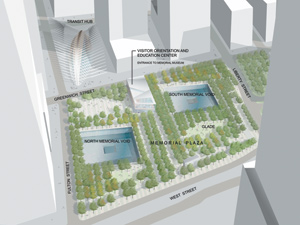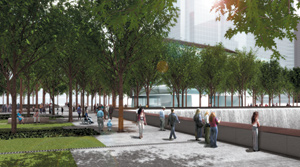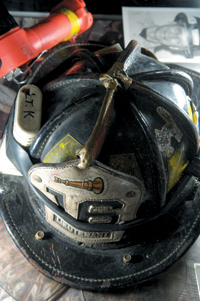|
||
      |
Features ::
Caretaker of Memory
World Trade Center Memorial and Museum Director Alice Greenwald, AM’75, is charged with memorializing an event seared in the minds of a generation.
On September 11, 2001, Alice Greenwald, AM’75, was unpacking boxes. Four days earlier she had moved from central New Jersey to Washington, D.C., for a new job at the U.S. Holocaust Memorial Museum. Shortly before 9 a.m.—after carpenter Bernard Nichols had arrived to install radiator covers—Greenwald’s husband David, on his way to New York on business, called from the train. “Could you please turn on the television and see what’s going on?” he asked. “They’ve stopped the train in Philadelphia.” On the Today Show, the first plane had already hit the World Trade Center’s north tower. Nichols came into the room, and they saw the second plane hit. Greenwald and her husband realized his train wouldn’t reach New York. “I’ll keep you posted,” he said.

Greenwald and Nichols continued to watch, “dumbstruck by what we were seeing.” When the south tower crumpled to the ground in a suffocating cloud, they “spontaneously hugged,” she says. “The impulse was to connect with a human being.”
Overnight, the world “felt like it had shifted,” she says, including at the Holocaust Museum, where “there was a sense that as a national memorial we needed to pay attention” to the aftermath. She recalls a slight bump in visitation—“the need for people to encounter a place where remembrance was the focus”—before tourism plunged.
At the time she felt close to the events, but since then she’s become much closer. This past February Greenwald was named director of the World Trade Center Memorial and Museum. Scheduled to open September 11, 2009, at ground zero—a burial site for victims never recovered—the memorial and museum have profound significance for victims’ families and friends; for the city, which lost a sense of invincibility; for the country, which grieved along with New York, Washington, and Pennsylvania; and for the world, which watched the events unfold on television. How to memorialize such a tragedy?
As unprecedented as the job ahead seems, Greenwald has tackled a similar task. After graduating from Sarah Lawrence in 1973, she studied the history of religions at Chicago’s Divinity School, working summers at the city’s Spertus Institute of Jewish Studies museum. Curatorial posts at Los Angeles’s Skirball Cultural Center and Philadelphia’s National Museum of American Jewish History followed. Then in 1987, while pregnant with her second child, Greenwald switched to part-time work—home-based research for the planned Holocaust Museum. Soon she was traveling to Washington once a week, a consulting job that lasted 14 years. Although originally part of the design team, when the museum opened in 1993, she says, “I worked on everything”—recommending items, helping to shape exhibits, honing the permanent installation text, writing a fund-raising case statement. The museum offered her full-time work, but she declined until summer 2001, when David’s Wall Street advertising firm transferred him to D.C. In August that year she was hired as associate director for museum programs. The family moved September 7.

Bird's-eye view of the memorial site.
“Alice has an eloquent way of talking about memory and history,” says William Parsons, U-High’63, the Holocaust Museum’s chief of staff. “She has a great sensitivity to the victims of genocide and an understanding of what memorials are about. That’s why she eventually got the call to come up to New York.”
In fact it was a series of calls. In summer 2005 a delegation from the World Trade Center Memorial Foundation visited the Holocaust Museum, and Greenwald learned about the director opening. “At the Holocaust Museum you’re asked these kinds of questions all the time—about the uses of memory, why remember. If you can’t begin to address that, you can’t be effective,” she says. “I felt my training at the Holocaust Museum, and the process of watching the museum go from a dream to reality, were a direct fit.” Meanwhile both her son and daughter were attending college in New York, so the move would bring her closer to them. By January 2006 she had the job.
FROM THE 20TH FLOOR of One Liberty Plaza in Lower Manhattan, the World Trade Center Memorial Foundation offices directly overlook ground zero. On a July morning the square parcel, enclosed by a tall chain-link fence, is a pile of gray dirt and concrete bisected by a reconstructed road and a commuter train station. Toward the west, two rectangular cavities reveal where the Twin Towers once stood, and yellow and orange construction equipment dots the entire site. The gap in the cityscape provides a view of boats on the Hudson between the World Financial Center buildings. To the north, the rebuilt Tower Seven, with less than 20 percent of its 1.7 million square feet leased, sparkles in the sun. To the south stands the gutted Deutsche Bank building, its demolition further delayed after bone fragments were found on the roof in April.
Five years after 9/11, ground zero is one of New York City’s most heated issues. Politicians, victims’ families, businesspeople, and architects have quarreled over what should go there, whether memorial or commerce should take precedence, how best to commemorate the dead yet show American resilience.
The original ground-zero plan called for the 9/11 memorial and museum; a commercial Freedom Tower at least as tall as the Twin Towers; a performing-arts center; and an International Freedom Center (IFC)—a cultural center focused on global struggles for freedom, sharing space with a visual-arts museum. The IFC was thwarted by Take Back the Memorial, a victims’-families group. “The public will have come to see 9/11 but will be given a high-tech, multimedia tutorial about man’s inhumanity to man, from Native American genocide to the lynchings and cross-burnings of the Jim Crow South, from the Third Reich’s Final Solution to the Soviet gulags and beyond,” wrote activist Debra Burlingame, whose brother was a pilot on the plane that hit the Pentagon, in a June 2005 Wall Street Journal op-ed. “This is a history all should know and learn,” she wrote, but not at ground zero. Burlingame took her fight to cable news shows, and by September 2005 New York Governor George Pataki had scrapped the IFC.
The memorial’s design also provoked disputes. Architects Michael Arad and Peter Walker’s winning plan, “Reflecting Absence,” would place two pools in the Twin Tower footprints, with water cascading from the perimeters. The pools, surrounded by groves of trees, “are large voids, open and visible reminders of the absence,” Arad wrote in the contest entry. Visitors would walk down ramps to galleries at pool level, where they’d contemplate a wall of 2,979 victims’ names—those who died on 9/11 and in the 1993 World Trade Center attack. The museum would lie further underground.
Yet when the estimated price tag for the eight-acre memorial and museum quadrant reached $1 billion this spring, Pataki and New York City Mayor Michael Bloomberg brought in a building consultant to scale it back. Because of the design and cost uncertainties, the World Trade Center Memorial Foundation halted fund-raising. Some family members, meanwhile, protested against placing the names below grade. The consultant’s design, eliminating six of the eight underground galleries and moving the names above ground on parapets surrounding each waterfall, reduced the estimated cost to about $700 million. The episode caused a rift between the politicians (Pataki and Bloomberg) and foundation president Gretchen Dykstra—who had hired Greenwald. Dykstra resigned in May.
The matter of victims’ names remains unsettled. While Arad and Walker had planned to arrange the names randomly—a proposal Pataki and Bloomberg endorsed—to avoid imposing any sort of hierarchy, many family members have urged they be listed by affiliation: firefighters, companies, airplanes.

GREENWALD KNEW WHAT SHE WAS STEPPING INTO when she took the job and moved to Battery Park. The controversies are “consistent with what always happens with memorials,” she says. “New York is so much in the public eye, and the impetus to rebuild is so imperative. Memory is unlike other projects.” Victims and their families, she concedes, “legitimately have perspectives that are different than those less personally affected.”
During the Holocaust Museum’s planning, “every issue was a razor’s edge,” agrees Indiana University’s Ed Linenthal, author of Preserving Memory: The Struggle to Create America’s Holocaust Museum (Viking, 1995; Columbia University, 2001). Questions tormenting that project, Linenthal says, included: “Where should this institution be? In New York? In D.C.? Adjacent to the Washington mall? Should the building be expressive of the event? What should the permanent exhibition be like? Is it an American museum or a Jewish museum? What kinds of photographs do you use to do justice to the event? How do you balance the interests of the survivors with those of the museum staff? Do you have a cafeteria? If so, is it kosher? Do you follow the Jewish calendar or the secular calendar?
“All of these things were controversial and vital, painful questions.”
Linenthal, who also wrote The Unfinished Bombing: Oklahoma City in American Memory (Oxford University Press, 2001), says similar questions surrounded the Oklahoma City National Memorial, which opened five years after the 1995 bombing that killed 168 people, and its accompanying museum, which opened in 2001. There some family members “became invested in a particular design: ‘Only an angel can honor my loved one,’ or, ‘Only a grove of trees.’” Yet they eventually reached a common understanding. “Through a mindful, sensitive process, the people came to see that none of them were going to get their particular wish but had to come together to see the memorial as part of the larger civic culture,” he says. The planners also developed “a written understanding that politicians were not going to muck about in the process”—an advantage already lost in New York.
“In New York,” says Linenthal, who sits on the Federal Advisory Commission for a future Flight 93 memorial in Shanksville, Pennsylvania, “there’s a real challenge because there is a complex web of interests enmeshed in this 16-acre site—commercial, transportation, cultural, neighborhood, memorial. It’s complicated because human remains no doubt are present. It’s a charged space. I have a lot of admiration for what Alice and her team will do.”
One thing Greenwald already has done is invite experts such as Linenthal to meet with the museum staff and foundation board. During a July visit Linenthal “gave us a number of case studies from Oklahoma City and the Holocaust Museum,” Greenwald says, “and let people know that creating a memorial is always fraught with controversy”—a sign of “great passion on all sides.”
Another expert she enlisted is Stephen Brier, of CUNY’s graduate center, who’s developed interactive-history installations for the Chicago Historical Society, New York Historical Society, and the National Museum of American History. Brier helped create the 9/11 digital archive (www.911digitalarchive.org), which collected thousands of essays, images, audio stories, and movies. “As historians we were compelled by the nature of the events of September 11,” he says. “If we didn’t create a format to collect these images quickly, they’d be lost.” Preparing for his August talk with the staff, Brier planned to “challenge” the board “to think about the memorial in the broadest possible way” and to “resist the pressures” they face about victims’ names, for instance. “The death was random. You don’t want to create a hierarchy of suffering but an equality of suffering.”

Brier also hoped to give the staff ideas for using technology. Rather than a museum’s traditional approach of displaying a letter or artifact, “you could show video of people” leaving flyers of missing relatives or convey immediacy through an exhibit rotating the thousands of digital images photographers took that day.
Bringing in these experts has been a unifying experience, says Paula Grant Berry, one of seven 9/11 family members on the memorial foundation board (another is Burlingame). “We’ll now be on the same page, which is helpful,” Berry says. She also appreciates Greenwald’s “sense of timing.” The Holocaust Museum was built 48 years after the end of World War II. “We don’t have 40 to 50 years,” Berry notes. Greenwald “will see the need for phases and recognize where this museum will be 40 to 50 years out. ... This is going to be a museum that evolves over time.”
Greenwald recognizes the timing difference but argues, “The impulse to memorialize is immediate.” A Warsaw memorial went up a few years after World War II ended, she stresses, and legislation to create Israel’s monument, Yad Vashem, was enacted in 1953. “It’s never too soon to memorialize and honor those who were lost,” she says, “never too soon to address the legacy of memory. The choices we make in how we tell the story will codify the event. The fact remains that 9/11 is the single biggest loss of life on American soil since the Civil War. It’s the trauma of our generation. The need to process that type of trauma is what memorialization is about.”
The staff must decide which items will best memorialize that trauma. The process begins by writing a narrative, a task Greenwald hopes to start this summer. “The exhibition narrative is your story line, how the museum will flow—what will go there in the biggest sense, what your messages are.” One message, for example, might be that “everything changed on 9/11, not just for the people closest to it, but everybody recognizes that something fundamentally shifted in our world.” Besides ground zero, the museum also will pay homage to the Pentagon, Shanksville, and 1993 victims. “This is a story-driven museum—not even technically a history museum but a memorial,” she says. “It’s a story rooted in remembrance.” Which brings up another decision: how graphic will the images be? Can the museum tell the story honestly without showing video of people jumping from buildings? Perhaps, Greenwald suggests, she will take a page from the Holocaust Museum and enclose explicit images with a wall so visitors may choose to skip them. And will the museum discuss terrorism? Pointing to a copy of the 9/11 Commission Report on her shelf, she notes that the institution “will have to have context,” but it’s “not a museum to Al Qaeda. This is the place people lost their lives. Our obligation is to their memory.”

The Holocaust Museum’s Parsons agrees that the victims and their families are the World Trade Center Memorial’s central constituency. In the Holocaust Museum’s case it was the survivors. “If we had violated their trust,” Parsons says, “we would have lost. The survivors trust us; they see the institution as a place that holds true their promise to their parents to tell the story. They can disagree with us, but we listen to them always.” If not for that relationship, he says, “we could have never expanded to talk about Darfur”—the Holocaust Museum helped start the Save Darfur movement, he says, and Holocaust survivors have protested at the Sudanese embassy. Oklahoma City too, he says, “has gone onto something bigger: freedom.” That memorial and museum “tell the story of the day, but the lessons and messaging are about how fragile democracy is.”
Far from expanding the museum’s mission, Greenwald is eager simply to begin. To that end, in August the Port Authority granted a contract to start foundation work, and the museum made its first major acquisition: a 7-foot-8-inch fiberglass Statue of Liberty, placed outside a Midtown firehouse after 9/11 and covered with hundreds of personal tributes. Such an object conveys hope, reflecting Greenwald’s own perspective. “In the midst of the worst of humanity, you always get the best of humanity.” At the Holocaust Museum, “not a day went by that I was not touched by something. In the worst possible moments people did things I don’t know if I could have done.” And to those people, she feels, “you owe something.” So she continues to raise money and to unite the foundation. Despite all the controversies, she says, “I fundamentally believe we can build the museum we want to build”—a museum that honors the history made the September morning that, as she unpacked moving boxes, the world shifted.